新人教版六年级下册英语知识点汇总
新人教版小学英语六年级下册各单元重点考点总结
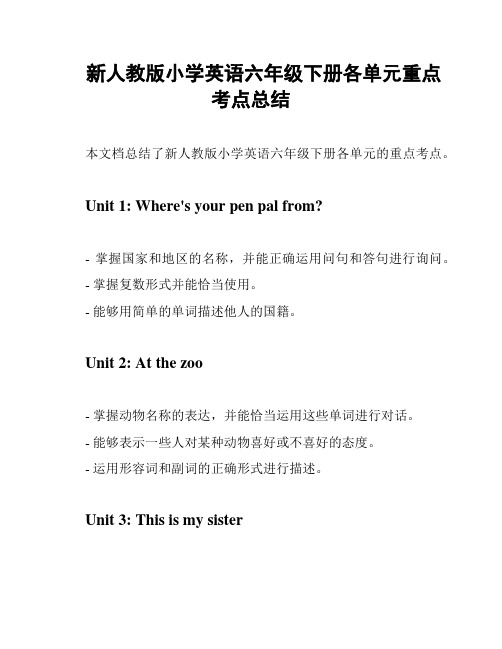
新人教版小学英语六年级下册各单元重点考点总结本文档总结了新人教版小学英语六年级下册各单元的重点考点。
Unit 1: Where's your pen pal from?- 掌握国家和地区的名称,并能正确运用问句和答句进行询问。
- 掌握复数形式并能恰当使用。
- 能够用简单的单词描述他人的国籍。
Unit 2: At the zoo- 掌握动物名称的表达,并能恰当运用这些单词进行对话。
- 能够表示一些人对某种动物喜好或不喜好的态度。
- 运用形容词和副词的正确形式进行描述。
Unit 3: This is my sister- 掌握表示家庭成员关系的词汇,并能在合适的情境下熟练使用。
- 能够用简单的句子表达自己和他人的家庭成员状况。
- 掌握疑问句和肯定/否定回答的语法结构。
Unit 4:What do you usually do on weekend?- 掌握表示日常活动和娱乐爱好的名词和动词,并能在合适的情境下熟练使用。
- 能够描述周末的计划,并能够用适当的时态表达过去、现在和未来的时间。
- 学会以礼貌的方式询问和回答他人的问题。
Unit 5: What's the matter?- 能够描述自己的身体不适,并能运用一些常用的疾病词汇。
- 掌握表示询问、建议和回答的用语,并能在合适的情境下使用。
- 学会表示关心和病愈等祝福的表达方式。
Unit 6: It's raining- 学会用简单的句子描述天气情况,并能表达对不同天气的态度。
- 掌握天气形容词的表达方式。
- 能够描述不同季节的气温、天气和风景。
总之,在学习小学英语六年级下册的过程中,应注重关注以上重点考点,并在实际中多进行运用练习,以此提高英语水平。
人教版六年级英语下册基础知识要点
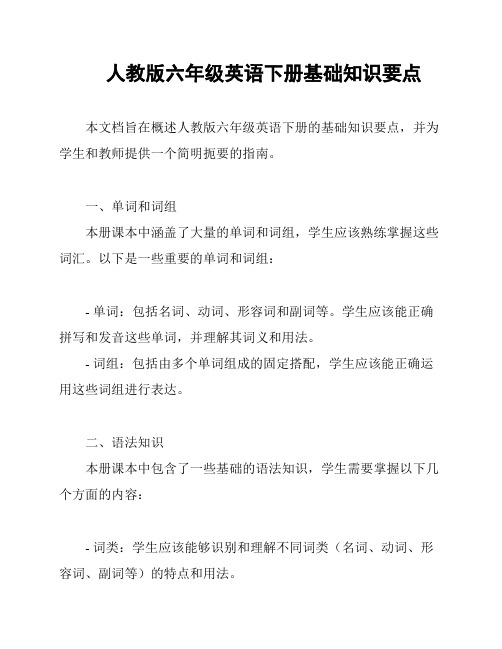
人教版六年级英语下册基础知识要点本文档旨在概述人教版六年级英语下册的基础知识要点,并为学生和教师提供一个简明扼要的指南。
一、单词和词组本册课本中涵盖了大量的单词和词组,学生应该熟练掌握这些词汇。
以下是一些重要的单词和词组:- 单词:包括名词、动词、形容词和副词等。
学生应该能正确拼写和发音这些单词,并理解其词义和用法。
- 词组:包括由多个单词组成的固定搭配,学生应该能正确运用这些词组进行表达。
二、语法知识本册课本中包含了一些基础的语法知识,学生需要掌握以下几个方面的内容:- 词类:学生应该能够识别和理解不同词类(名词、动词、形容词、副词等)的特点和用法。
- 句型:学生应该能够理解和运用一些基础的句型结构,如主语+谓语、主语+谓语+宾语等。
三、听力和口语听力和口语是语言研究中重要的方面。
学生需要通过听力练和口语训练来提高自己的听力和口语能力。
以下是一些学生可以进行的活动:- 听力练:学生可以听录音材料,理解其中的对话和内容,并进行相关练。
- 口语对话:学生可以通过与同学或教师进行对话,提高自己的口语表达能力。
四、阅读和写作阅读和写作是研究英语的重要环节。
学生需要通过阅读文章和写作练来提高自己的阅读和写作水平。
以下是一些建议:- 阅读文章:学生可以选择适合自己水平的英语文章进行阅读,了解文章的内容和结构,并进行相关阅读理解练。
- 写作练:学生可以通过写作练来提高自己的写作能力,如写日记、作文等。
五、其他要点除了以上内容外,学生还应该注意以下几个要点:- 研究方法:学生应该根据自身情况选择适合自己的研究方法,如多听多说、多读多写等。
- 复和总结:学生应该及时复所学内容,并进行总结和归纳,以便更好地掌握知识。
总结:本文档概述了人教版六年级英语下册的基础知识要点,包括单词和词组、语法知识、听力和口语、阅读和写作等。
学生和教师可以根据这些要点进行相关学习和教学活动,以提高学生的英语水平。
最新人教版六年级英语下册各单元知识点总结归纳
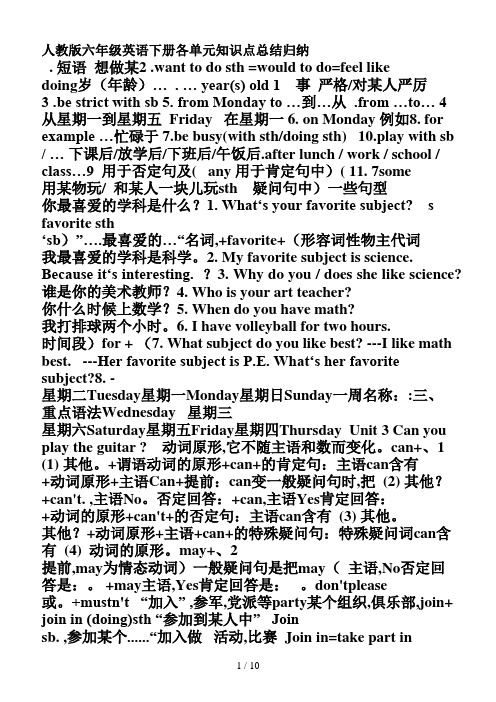
人教版六年级英语下册各单元知识点总结归纳. 短语想做某2 .want to do sth =would to do=feel likedoing岁(年龄)… . … year(s) old 1 事严格/对某人严厉3 .be strict with sb 5. from Monday to ...到...从 .from ...to (4)从星期一到星期五 Friday 在星期一 6. on Monday 例如8. for example …忙碌于 7.be busy(with sth/doing sth) 10.play with sb / … 下课后/放学后/下班后/午饭后.after lunch / work / school / class…9 用于否定句及( any 用于肯定句中)( 11. 7some用某物玩/ 和某人一块儿玩sth 疑问句中)一些句型你最喜爱的学科是什么?1. What‘s your favorite subject? s favorite sth‘sb)”….最喜爱的…“名词,+favorite+(形容词性物主代词我最喜爱的学科是科学。
2. My favorite subject is science. Because it‘s interesting. ?3. Why do you / does she like science? 谁是你的美术教师?4. Who is your art teacher?你什么时候上数学?5. When do you have math?我打排球两个小时。
6. I have volleyball for two hours.时间段)for + (7. What subject do you like best? ---I like math best. ---Her favorite subject is P.E. What‘s her favorite subject?8. -星期二Tuesday星期一Monday星期日Sunday一周名称::三、重点语法Wednesday 星期三星期六Saturday星期五Friday星期四Thursday Unit 3 Can you play the guitar ? 动词原形,它不随主语和数而变化。
(完整版)人教版六年级下册英语知识点总结
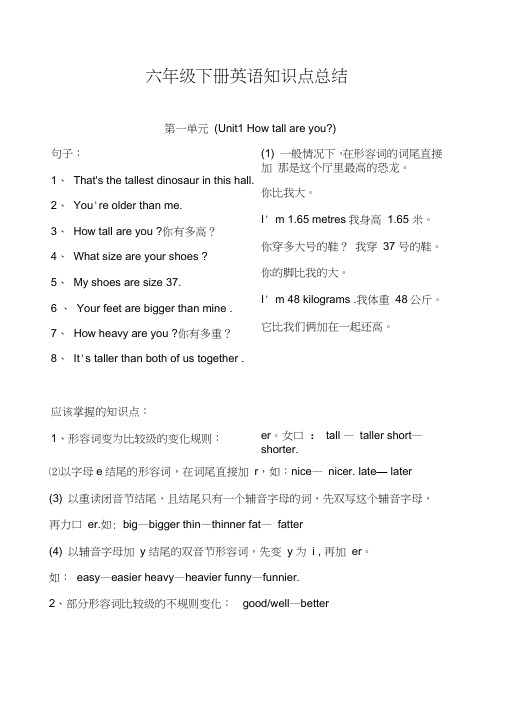
六年级下册英语知识点总结第一单元(Unit1 How tall are you?)句子:1、That's the tallest dinosaur in this hall.2、You're older than me.3、How tall are you ?你有多高?4、What size are your shoes ?5、My shoes are size 37.6 、Your feet are bigger than mine .7、How heavy are you ?你有多重?8、It's taller than both of us together .应该掌握的知识点:1、形容词变为比较级的变化规则:(1) 一般情况下,在形容词的词尾直接加那是这个厅里最高的恐龙。
你比我大。
I' m 1.65 metres我身高1.65 米。
你穿多大号的鞋?我穿37 号的鞋。
你的脚比我的大。
I' m 48 kilograms .我体重48公斤。
它比我们俩加在一起还高。
er。
女口: tall —taller short—shorter.⑵以字母e结尾的形容词,在词尾直接加r,如:nice—nicer. late— later(3) 以重读闭音节结尾,且结尾只有一个辅音字母的词,先双写这个辅音字母,再力口er.如: big—bigger thin—thinner fat—fatter(4) 以辅音字母加y 结尾的双音节形容词,先变y 为i , 再加er。
如:easy—easier heavy—heavier funny—funnier.2、部分形容词比较级的不规则变化:good/well—better3、 比较级的标志:tha n 。
弓I 导比较级的特殊疑问词: Which 。
句子结构为:Which+名词+is+形容词比较级。
比较级+and+比较级表示:越来越 ...4、 A 与 B 比较的句子结构: A+be 动词+形容词比较级 +than+B. 否定句句子结 构:A+be 动词+not+形容词比较级+than+B. —般疑问句句子结构:Be 动词+A + 形容词比较级 +than+B ?A 比B 多多少的句子结构:A+be 动词+数字+单位+形容词比较级+than+B 。
小学英语-人教pep-六年级下-知识点汇总

Unit 1 How tall are you?你有多高?1. WordsNo. English Part ofspeechChinese Extension1 younger adj.更年轻的younger是形容词young 的比较级。
2 older adj.更年长的older是形容词old的比较级。
3 taller adj.更高的taller是形容词tall的比较级。
4 shorter adj.更矮的,更短的shorter是形容词short的比较级。
5 longer adj.更长的longer是形容词long的比较级。
6 thinner adj. 更瘦的thinner是形容词thin 的比较级。
7 heavier adj. 更重的heavier是形容词heavy的比较级。
8 bigger adj. 更大的bigger是形容词big的比较级。
9 smaller adj. 更小的smaller是形容词small的比较级。
10 stronger adj. 更强壮的stronger是形容词strong 的比较级。
11 lower adj. 更低地lower是形容词low的比较级。
12 smarter adj. 更聪明的smarter是形容词smart的比较级。
13 dinosaur n. 恐龙dinosaur还有守旧落伍的人的意思。
14 hall n. 大厅h+all(全部)=hall(大厅)。
15 than conj. 比than用于形容词/副词的比较级之后。
16 both pron. 两个都both of us 我们俩都。
17 kilogram n. 千克;公斤kilogram的缩写是kg。
18 countryside n. 乡村in the countryside 在乡村。
19 shadow n. 阴影;影子shadow与shade(荫;阴凉处)形似。
20 become vi. 开始变得;变成become的过去式为became。
完整版)人教版六年级下册英语知识点总结

完整版)人教版六年级下册英语知识点总结Unit 1: How Tall Are You?In this unit。
we learn how to compare height and shoe size。
and describe weight using the correct units of measurement.We use comparative adjectives to compare two things。
To form the comparative form of most adjectives。
we add -er at the end of the word。
For example。
tall es taller and short es shorter。
If the adjective ends in -e。
we simply add -r。
like in the case of nice ing nicer。
If the adjective ends in a single consonant after a stressed vowel。
we double the consonant and add -er。
as in biging bigger。
For adjectives ending in -y。
we change the -y to -iand add -er。
such as easy ing easier.Some adjectives have irregular comparative forms。
such as good/well ing better.To make a comparison。
we use the word "than" and the special n word "which." The structure for this is "Which + noun + is + comparative adjective?" We can also use "more + adjective" for longer adjectives.When comparing A and B。
人教版六年级下册英语知识点总结
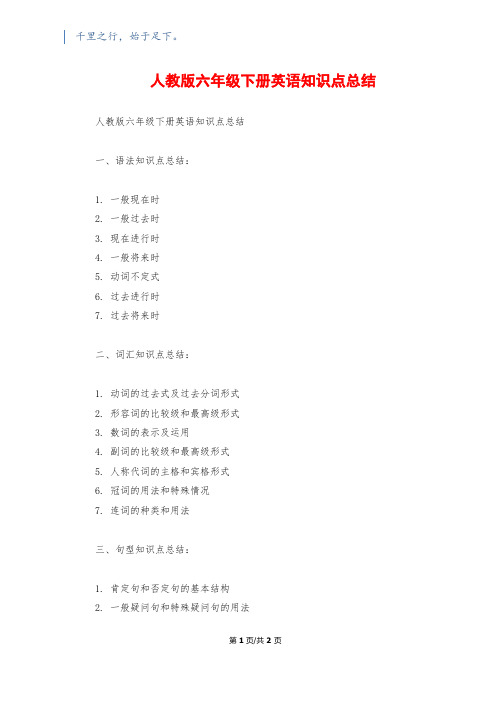
千里之行,始于足下。
人教版六年级下册英语知识点总结人教版六年级下册英语知识点总结
一、语法知识点总结:
1. 一般现在时
2. 一般过去时
3. 现在进行时
4. 一般将来时
5. 动词不定式
6. 过去进行时
7. 过去将来时
二、词汇知识点总结:
1. 动词的过去式及过去分词形式
2. 形容词的比较级和最高级形式
3. 数词的表示及运用
4. 副词的比较级和最高级形式
5. 人称代词的主格和宾格形式
6. 冠词的用法和特殊情况
7. 连词的种类和用法
三、句型知识点总结:
1. 肯定句和否定句的基本结构
2. 一般疑问句和特殊疑问句的用法
第1页/共2页
锲而不舍,金石可镂。
3. 感叹句的用法
4. 被动语态的构成和用法
5. 定语从句的引导词和结构
四、阅读技巧总结:
1. 阅读理解中的主旨理解和推断能力
2. 阅读理解中的细节理解和归纳总结能力
3. 阅读理解中的上下文推理和辨析能力
4. 阅读理解中的文章结构和段落内容的理解能力
五、写作技巧总结:
1. 英语作文的基本结构和要求
2. 英语作文的开头和结尾句型
3. 英语作文的衔接词和连接词的运用
4. 英语作文的语法结构和句式多样性
六、口语表达技巧总结:
1. 英语口语中的问候和自我介绍
2. 英语口语中的日常用语和口语表达
3. 英语口语中的交际技巧和场景应用
4. 英语口语中的听力和口语训练技巧
以上是关于人教版六年级下册英语知识点的总结,希望对你有所帮助。
六年级下册英语书笔记人教版
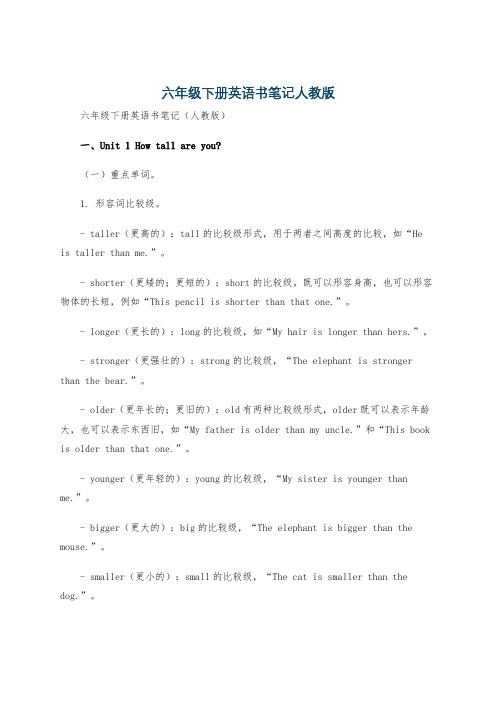
六年级下册英语书笔记人教版六年级下册英语书笔记(人教版)一、Unit 1 How tall are you?(一)重点单词。
1. 形容词比较级。
- taller(更高的):tall的比较级形式,用于两者之间高度的比较,如“He is taller than me.”。
- shorter(更矮的;更短的):short的比较级。
既可以形容身高,也可以形容物体的长短,例如“This pencil is shorter than that one.”。
- longer(更长的):long的比较级,如“My hair is longer than hers.”。
- stronger(更强壮的):strong的比较级,“The elephant is stronger than the bear.”。
- older(更年长的;更旧的):old有两种比较级形式,older既可以表示年龄大,也可以表示东西旧,如“My father is older than my uncle.”和“This book is older than that one.”。
- younger(更年轻的):young的比较级,“My sister is younger than me.”。
- bigger(更大的):big的比较级,“The elephant is bigger than the mouse.”。
- smaller(更小的):small的比较级,“The cat is smaller than the dog.”。
- thinner(更瘦的):thin的比较级,“She is thinner than her sister.”。
2. 其他重点单词。
- centimeter(厘米):长度单位,缩写为“cm”,例如“I am 150 centimeters tall.”。
- meter(米):长度单位,缩写为“m”,“The building is 50 meters high.”。
- 1、下载文档前请自行甄别文档内容的完整性,平台不提供额外的编辑、内容补充、找答案等附加服务。
- 2、"仅部分预览"的文档,不可在线预览部分如存在完整性等问题,可反馈申请退款(可完整预览的文档不适用该条件!)。
- 3、如文档侵犯您的权益,请联系客服反馈,我们会尽快为您处理(人工客服工作时间:9:00-18:30)。
六年级英语下册知识点梳理一、单元内容简析:Unit 1 How tall are you?本单元内容的中心话题是询问人或事物的年龄、身高、重量以及长度并作比较。
内容涉及恐龙、猴子以及鲸类的比较,学生之间在年龄、身高和体重方面的比较。
二、单元词、句、语法等方面的知识重点:四会单词三会单词词二会单知词短语语法词法汇识taller,shorter,stronge,older,younger,bigger,funnier,heavier,longer,thinner,smaller(重点)little,tail,think,size,wear,yourscm(centimeter),than,funnier,kg(kilogram),feet,meter,ton,each,squid,lobster,shark,deep,seal,evensperm whale,killer whale,up to,dive into,good swimmer,the length of, line up,from to形容词比较级的变化规则:1、直接在形容词后加“er” , 例如 long---longer, tall---taller 。
2、以字母“ e”结尾的直接加“r”,例如nice---nicer 。
3、重读闭音节只有一个辅音字母结尾的,双写最后一个辅音字母后再加“er” , 例如thin---thinner,big---bigger 。
4、辅音字母加“y”结尾的先把“y”改为“ i”再加“ er”,例如 funny---funnier,heavy---heavier 。
5、部分双音节或多音节加“more”,例如 careful---more careful 。
6、不规则变化,例如good---better 。
句句型1、How +形容词+be+主语? 2、A+比较级+than +B.3 、主语+be+数字+单位+tall/heavy/long ,四会How tall are you?I ’m 164cm tall. Y ou are shorter than me. Y ou are 4cm taller子than me. How heavy are you?I ’m 48kg. I ’m thinner than you,and shorter(.重点)三、本单元难点:1、数字的读法,含有“厘米、千克”单位的读法。
如百以上 164:one hundred and sixty-four,学生可能读的时候百后不知加“and”,还有千的读法:thousand小,数的读法等。
2、形容词比较级的用法与变化形式,哪些要双写,哪些要把y 变 i 成再加er,到底在什么情况下变比较级要加上more。
3、代词的用法,特别是名词性物主代词的用法。
四、易考点与易错点:1、词语类:①四会词语在听力部分听写或笔试部分按照汉意写词语。
②按要求写词语:变比较级 funny,heavy,big,thin;long 的名词,foot,tooth 复数,heavy(heavier)的反义词 light(er)③very 修饰原级, much 修饰比较级。
例如: He is very tall. He is much taller than you.2、语法、句型类:①H ow 引导的不同特殊疑问句:How be sb.?(问某人状况),H ow tall/heavy/old be sb./sth?(询问身高、体重、年龄)H ow long/big/large be---?(问多长、多大)How many/much(问数量、价格)。
②比较级的运用,一定要是相同内容或类别才可以进行比较,这是学生最易出错和混淆娥地方。
例如:Mike’s legs are longer than (John),如果学生翻译会直接填写John,但是一分析就不难发现应该和John的腿作比较的,所以应该是John’s。
再比如 My hair is是填 hers才是longer than (she).如果不仔细分析大多数学生都会错填成:she,her但,正确的。
Unit 2 What ’s the matter,Mike?一、单元内容简析:本单元的教学内容主要是围绕“看病就医”和“描述心情”两个话题展开。
二、单元词、句、语法等方面的知识重点:单hurt,matter,sore,nose,tired,excited,ang,r h y appy,bored,sad(重点)四词会短have a fever,have a cold,have a headache,have a sore thr(oa重t 点)词语三单people,know,pass,guess,game会词单feel,sick,flu,might,worry,medicine,drink,stay,better,soon,trip,fail,test,hear,match,be二词tween,kick,goal,another,win(过去式 won)a little,laugh at,feel sick,broken leg,have/get the flu,don’t worry ,see a doctor,take汇短some medicine,drink hot drinks,stay in bed for a few days,feel better,look so会语happy,go on a big trip,fail the math test, at the end ofa footballmatch,between---and---,pass---to---,kick the ball,fly into,bounce off时态一般现在时:(注意主语是第三人称单数的句子)句句式How+助动词+主语+动词原形? 主语+ have/has +疾病类单词子四会What’s the matter with you?/What’s wrong with you? My nose is sore. My nosehurts. How are you? Y ou look so happy. You look sad today.(重点)三、难点是学生能在各种语言环境中正确熟练地运用不同句型进行交流。
四、易考点与易错点:1、词语:①四会词语和短语会出现于听力部分的补全句子或按汉语意思翻译。
②了解“疼痛”的区别:hurt 是动词指“使受伤”,ache是名词后缀 ,加上身体某部位常指某部位疼痛, sore是形容词可以放在表示身体某部位的词语前作定语或放在be 动词后做表语。
hurt 和sore有时可以替换。
armache,stomachache I hurt my nose. My nose hurts.My nose is sore.②注意people是集合名词,单数和复数同形;medicine 是不可数名词,没有复数形式。
③短语“为某人买某物”,buy sb. sth./buy sth.for sb.当某人放在前面时不用加 for,否则要加介词 for. buy me a ball, buy a ball for me ④ be going to 后跟动词 ,be going on 后跟名词,表示将要或打算做什么事情。
2、句型:①What’s wrong with you? 和 What’s the matter with you?意思和用法相同, matter名词要加,而wrong 是形容词,常在选择和改错题中出现。
②注意当主语是第三人称单数的时候,如果没有be 动词,谓语动词要加s 或 es,否定句和疑问句要用does。
Mike has(have) a headache. How does(do) your father feel? He doesn’t (not) feel well.Unit 3 Last Weekend一、单元简析:本单元主要是学习和运用一般过去时来表达在过去的时间内所做的事情。
二、单元词、句、语法等方面的知识重点:四会单词watch----watched,wash----washed,clean----cleaned,play -------------- playedvisit----visited,do----did,go----went,read --------- read,last,weekend,park 词(重点)短语go swimming,go fishing,go hiking (重点)知三会单词cook----cooked,study studied汇二会单词yesterday,return,fly---flew,swim ------- s wam短语tongue twister时态一般过去时识句式或句型1、主语+动词过去式+过去时间.句2、What+d id+主语+ do+过去时间? 3、Did+主语+动词原形+过去时间?四会句子What did you do last weekend? I played football.点Did you read books? Y es, I did. No, I didn ’t. (重点)子三会句子I visited my grandparents.What did you do yesterday? I went hiking.一般过去时态的构成动词肯定式否定式一般疑问句I was--- He/She/It was--- We/You/They were--- I was not(wasn’t)--- He/She/It wasn’t---We/Y ou/They/werenot(weren’t)Was he/she/it---? Were you/they---?实意I/He/She/It+动词过去式动词We/You/They +动词过去式I/He/She/It+ didn’t+动词原形We/You/They +didn’t+动词原形Did he/she/it+动词原形 ? Did you/they +动词原形 ?be三、难点:1、了解一般过去时态的意义和用法。
2、动词过去式的变化规则: A 规则变化①一般在动词原形末尾加ed。
②动词原形词尾是字母e 的直接加 d。
③末尾只有一个辅音字母的重读闭音节词,先双写这个辅音字母,再加 ed。
④动词结尾是辅音字母加y,把y 变为i 再加ed。
B 不规则变化:要求背诵记忆。
3、规则动词过去式的读音:①清辅音后面读/t/;②元音和浊辅音后读/d/;③在 /t/和/d/音后读/id/。
